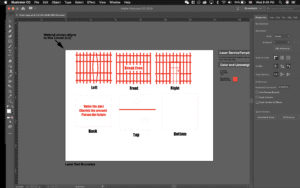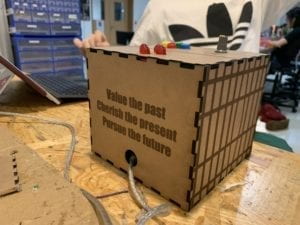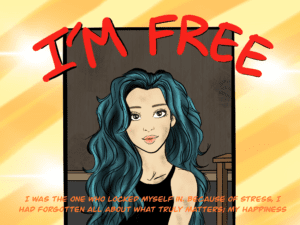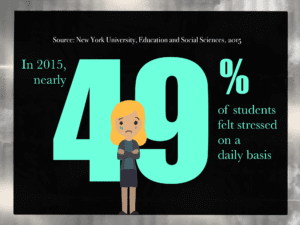Project Name: Break Free
Partner: Kenneth Wang
Professor: Young
Conception and Design
My Partner, Kenneth and I decided that for this project, we would resemble it after the popular game genre known as escape rooms. We were especially intrigued by how within its nature, Escape Rooms are constantly asking for input from the users involved. Kenneth and I knew that we wanted our users to continuously place input, and found that it would be interesting for the users to interact with the project by navigating its interface and deciphering all of its clues and hints in order to reach its goals. The project would then process the user’s information and input and then create its own input to help the user complete the game, together they would be working towards a common goal: escape from the room. We wanted the room to be easily recognizable and easily understood as to where the end goal should be, which is why we only created one room instead of multiple. we wanted the user to familiarise themselves with the room and not to confuse themselves with multiple aspects and attributes. the next decision we accounted for on behalf of the user’s interaction with the project was the physical gameplay. I designed the box through illustrator and spent a lot of time decorating the box to make it fit the criteria of the project, which I did by creating a bunch of bars around the box to resemble those of jail cells. In my intentions, this design would further the objectives we wish to convey: a restrictive environment. We then purchased multiple buttons, joysticks, and potentiometers off of the internet and then borrowed LEDs from the equipment room to use atop of the main controller for the game, which is the box. These components proved to be the best for our project for they gave users a reminiscent feeling of video game controllers which automatically told the user that the project was indeed a video game that they could interact with. Another option was simply just using the computer’s keyboard and mouse for the user to interact with the interface, but we rejected that idea because we thought that it would be inferior, redundant and boring for the user to just use the keyboard and mouse to solve the game.



Fabrication and Production
In the beginning, Kenneth and I had a lot of difficulty with trying to understand what we wanted to do for this Final Project. For the midterm, we had created a game that did not require any sort of strategizing or deep thinking, and so we wanted to change that this time around. As I was put in charge of the designing process for the project, I put a lot of effort and attention into the physical appearance of the project, which includes the box as well as the art for the Escape room. Creating the box took a few times to get used to, but because of my previous experience from the last project, I was able to minimize my trials with the fabrication lab. I wanted the design to be sleek and minimal so that it would appear clean and easy to understand for the user. Then, I went on to creating art for the project. Each picture and image found within the project was hand drawn by myself through applications such as Illustrator, Photoshop and Procreate on my iPad. It wasn’t until during the drawing process that I had familiarised myself with the Procreate app. I had to watch several videos and tutorials on the internet in order to understand the complete interface of the application, only after that, did I feel comfortable with creating my own pieces of art.


Kenneth and I had to discuss and brainstorm a lot of aspects to the design because we wanted it to be perfect and congruent. There are times where agree with another as well as disagreed, which I believe only created a better outcome in the end. There are many times where I would have to draw for 5 to 6 hours a day, which I did not entirely mind because I was doing it to create a better project for both my partner and I. For the user testing, we received a lot of compliments but also a lot of suggestions and worries for the rest. We were told that the game was kind of confusing due to the lack of instructions, the users believed that if we were to add simple instructions that were minimal and did not distract them from the game, then the project would benefit overall.
To conform to these suggestions, I added symbols and labels to the items found on top of the box so that they would be easier to locate. Kenneth then added instructions to the game through forms of animation that would direct the user through the interface. We also incorporated newly added LEDs to the box so that they could correspond to the codes and hints that we created throughout the game, which furthermore helped the user understand the game’s intentions and goals. Honestly, I do believe the suggestions helped us in creating a better project and so they were effective as well.
Conclusions
The goal of this final project is to create a fascinating interface or game that reflects our ideals of interactive devices. To Kenneth and I, we believe that interaction details a dynamic relationship between two or more users who continuously place input into one another depending on the other’s output, and of course, they must work towards a common goal. In our project, the user is working to understand the rooms’ hints in order to decipher them and discover a clue that allows the character to escape from the final room. The interface of the room is then processing the input that the user places into it, processes it, and then creates it’s on output that would help the user to reach the final goal. For the most part, I believe that the final project perfectly aligns with our definition of interaction, but I do believe that there could be a misunderstanding of a reaction instead of interaction. We were thankful and in relief that with user testing and our final project presentation, the volunteers perfectly interacted with the project as to how we had planned. I do wish if we had the luxury of time, that we could create more complex levels and rooms for the user to go through, this would lengthen the overall project also raise even more awareness to the issue we had chosen. We’ve learned, how much thinking and designing must go into the project in order to create a fully useful device. We should have implemented different aspects such as sound effects and a longer story in order to deepen the project’s meaning. I believe that teamwork is super important in this aspect and communication as well, I am grateful to have worked with Kenneth this time around for the final project.
With this Project, we wanted our goal to be that of raising awareness on the stress and mental illnesses that arise within college students and in academic environments. We both understand that is it is extremely difficult and even almost impossible to cure someone of these illnesses through a simple project like this, but we wish to at least raise awareness of the growing issue. We conducted an immense amount of research in information in order to back up our claims and goals. We wanted to turn the awareness issue into the form of a game in order to make it seem more interesting, and for it to reach out to even more users in a more meaningful way. We believe that these people, students, and all users should care because it affects all of them, whether or not the mental illness is chronic or subtle, it is a part of us that should not be ignored.


